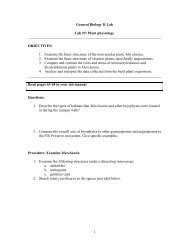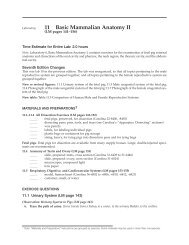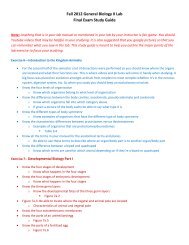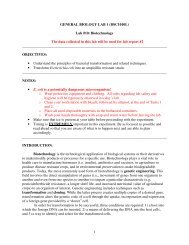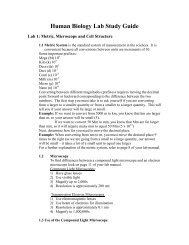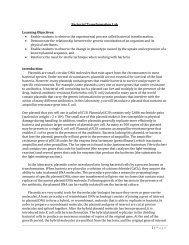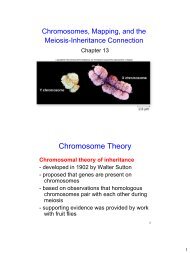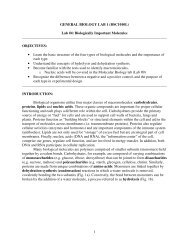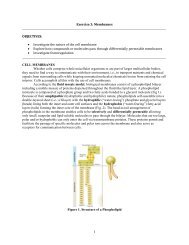Plant physiology
Plant physiology
Plant physiology
Create successful ePaper yourself
Turn your PDF publications into a flip-book with our unique Google optimized e-Paper software.
Figure 2. MarchantiaFigure 3. Liverwort Life Cycle3
Questions:1. Describe the types of habitats that Marchantia and other bryophytes were locatedin during the campus walk?2. Compare the overall size of bryophytes to other gymnosperms and angiosperms inthe FIU Preserve ecosystem. Give specific examples.Procedure: Examine Marchantia1. Examine the following structures under a dissecting microscopea. Antheridia (male)b. Archegonia (female)c. gemmae cups2. Sketch what you observe in the spaces provided below.Gemmae cupsMagnification: ______ArchegoniaMagnification: ______AntheridiaMagnification: _______4
Questions:1. Describe the general location of the antheridium and archegonium on the liveMarchantia and explain how location of these organs relates to their reproductivefunction?2. Are spores produced by the sporophyte diploid or haploid?a. What about gemmae, are they diploid or haploid?________________________________________________________________________Task 2: Compare the root systems of monocotyledonous and dicotyledonous plantsFollowing their transition onto land, the development of vascular tissue and rootsallowed plants to inhabit diverse environments. Specifically, roots function to: (1) anchorplants in the soil, (2) absorb water and minerals, and (3) store food. <strong>Plant</strong>s are generallycharacterized by either taproot or fibrous root systems (Figure 4a and 4b). While taprootsystems consist of one large main (primary) root from which smaller, secondary rootsmay arise, fibrous roots are a complex network of numerous fine roots, with primary andsecondary roots of equal size. Besides these two types of roots, some plants can grow anadditional type of root called adventitious roots. Adventitious roots can form fromdifferent portions of the plant including leaves, petioles, and stems. A type ofadventitious root is called the prop root which is commonly found in tropical trees wherewindstorms can often topple unsupported trunks. Figure 4c shows an example of a proproot found in corn to help support the plant. Examples of plants possessing taprootsystems include carrots and turnips and those with fibrous roots include rice and grasses.In most instances, dicots are characterized by taproot systems and monocots by fibrousroot systems.5
A. Taproot B. Fibrous RootC. Prop RootFigure 4. Types of root systemsDuring seed germination, a radicle (embryonic root), develops from the seedlingand grows downward into the soil. Depending upon the type of root system, the radiclemay develop into a thick primary root, i.e. a taproot, or into numerous branching rootscreating a complex network, as in the fibrous root system. Structurally, all roots,regardless of plant type, can be divided into the four regions, (1) root cap, (2) zone ofcell division, (3) zone of elongation, and (4) zone of maturation, illustrated in Figure 4.The main purpose of the root cap is to protect the apical meristem (zone of cell divisionresponsible for primary growth of the root) as the root tip pushes through the soil. Theroot cap secretes a mucigel, a slimy material that aids in the movement of the rootthrough the soil. The next region, the zone of elongation, is the area where newlygenerated cells increase in size, and in doing so, extend the length of the root, pushing it6
deeper into the soil. Beyond this region, no increase in size takes place. Instead, cellsmove into the zone of maturation where they mature and differentiate into specializedcells that function in absorption, conductance, protection and storage.Figure 5. Structure of a plant rootFigure 6. Seedling Structures7
Procedure 1: Examine fast plant and corn seedlings1. Last week you planted corn and fast plant seeds. Examine the developing rootsfrom each type of seedling and sketch your observations in the space provided.2. Identify the following structures. Use Figure 6 to help you identify them.a. radicle (embryonic root)b. cotyledons (seed leaves; function in the absorption of nutrients from theseed until the plant can produce leaves for photosynthesis)c. seedBrassica rapa (Fast <strong>Plant</strong>)Zea mays (Corn)Questions:1. What type of root system does Brassica rapa (Fast <strong>Plant</strong>) possess?a. What about Zea mays (Corn)?3. Based on the root systems present in each of the aforementioned organisms,which plant is a monocot and which is a dicot? Explain.4. What is the purpose of root hairs?8
a. Are root hairs present in both plants?===============================================================Procedure 2: Compare and contrast root and stems of monocots and dicotsIn addition to differences in root type, among other factors, monocots and dicotsalso vary in the arrangement of their vascular tissue, i.e. xylem, which transports waterand minerals, and phloem, which transports organic compounds. In dicot roots, phloemtissue lies between the arms of the xylem in the center of the root whereas in monocotroots, xylem and phloem form a ring. Vascular tissues in the stems of dicots lay in adistinct ring, as opposed to monocots, where the vascular bundles are scatteredthroughout.9
Procedure:1. Examine prepared slides of monocot and dicot roots and stems2. Identify the following structures:a. xylemb. phloemc. epidermisd. endodermis3. Note what you observe for each slide in the spaces provided below.Monocot RootMagnification: _____Dicot RootMagnification: _____Monocot StemMagnification: _____Dicot StemMagnification: _____10
Task 3: Review the different parts of a plant using your fast plants and flowersNow that you have examined the roots and stems of angiosperms, we will shiftour focus to the remainder of the plant body. Structurally, angiosperms are composed offive main parts: (1) roots, (2) stems, (3) leaves, (4) flowers, and (5) fruits (Fig. 7).Recall from last week’s lab that leaves are either simple or compound and are arrangedon the stem in one of three orientations: alternate, opposite or whorled. In angiosperms,the venation pattern of leaves (netted vs. parallel), as well as flower arrangement, alsodiffers between monocots and dicots. In addition, angiosperms differ with regard to thelocation of the male (stamen) and female (pistil) reproductive structures; monoeciousflowers possess pistils and stamens on different flowers but on the same plant whiledioecious flowers have male and female structures on two different plants.Hermaphroditic plants are plants that contain flowers which have both male (stamen)and female (pistil) reproductive structures on the same flower as shown in figure 8.Reproduction in angiosperms is sexual and, in contrast to Marchantia, involves doublefertilization whereby both a zygote and endosperm (nutritive tissue that supports thedeveloping embryo) are formed. As the embryo matures, it develops into a seed and as itdoes, the ovary enlarges into a fruit. In general, fruits function to protect the developingseed and also aid in their dispersal, i.e. their color, smell and taste attract animals whicheat them and then deposit the seeds at a considerable distance from the parent. Fruits aretypically classified as either simple, complex or dry. Simple fruits are further subdividedinto drupes (cherry), berries (tomato) and pomes (apple), complex fruits into aggregate(raspberry) and multiple (pineapple) and dry fruits into legumes (beans).Figure 7 Main parts of a plantFigure 8 Parts of a flower11
Figure 9. Comparison between monocot and dicotsProcedure 3A:Using your group’s fast plants, identify the structures illustrated in Figure 7. Use Figures7 and 8 to guide you, but keep in mind that Brassica rapa might not possess everystructure shown in these figures.Questions:1. Describe the leaf structure and arrangement observed in your Brassica rapaplants.a. Are the leaves simple or compound?b. How are the veins arranged on the leaves?c. Describe the leaf arrangement on the stems.2. If present, how many petals do the Brassica rapa flowers have?12
3. Based on your observations, is Brassica rapa a monocot or a diocot? Explain yourreasoning.Procedure 3B:Obtain a flower for your group and locate all the different parts of the flower using figure7 and then answer the questions below.Questions:1. Are the leaves simple or compound?2. What type of leaf venation does it have?3. What type of leaf arrangement does it have?4. How many petals does the flower have?a. Are the petals in sets?5. Based on the information you collected above, is your flower a monocot or dicot?How can you tell?===============================================================Task 4: Data analyses of the Basil experimentFive weeks ago you and your lab mates designed an experiment to determine therole of macronutrients on the growth of basil. Since then, you have been tracking yourplants across different treatments and recording the data each week. At this point, it istime to analyze the results of your experiments and determine whether your data supportsor rejects your hypotheses. Before beginning this task, answer the questions below toreview your experimental design and variables.13
1. What were your null and alternate hypotheses?a. H o :b. H a :2. What were your independent variables?3. What were your dependent variables?4. Which variables did you keep constant?Note: For the next part of this exercise, you will need to have the class data setthat your TA will provide.Mean = sum of all samples / number of observations in a sampleVariance = [sum (measured value for each sample – mean) 2 ] / (sample size -1)= ∑ (x-x) 2N-1Standard Deviation = √variance5. Record the class data below.14
6. Calculate the mean for the class data set. Show your work.7. Calculate the variance for the class data set. Show your work.8. Calculate the standard deviation for the class data set. Show your work.a. What does the standard deviation value tell you about your data?9. Using excel, graph the data on a line graph and attach it to your task sheet.a. Do you notice any trends?10. Based on the data collected, do you reject or fail to reject your null hypothesis?Explain your answer.11. How would you improve your experimental design?12. How could you expand upon this experiment?15



